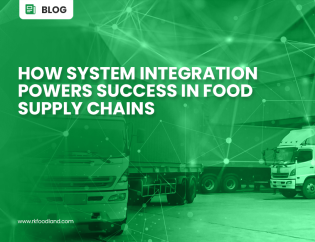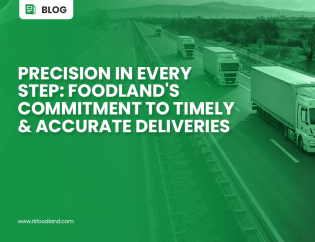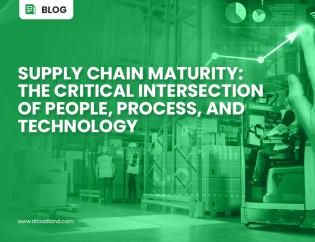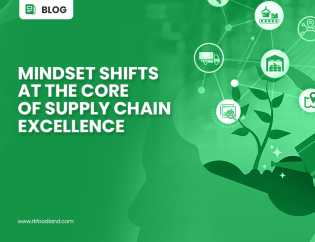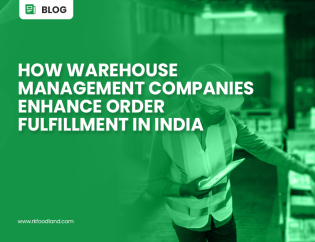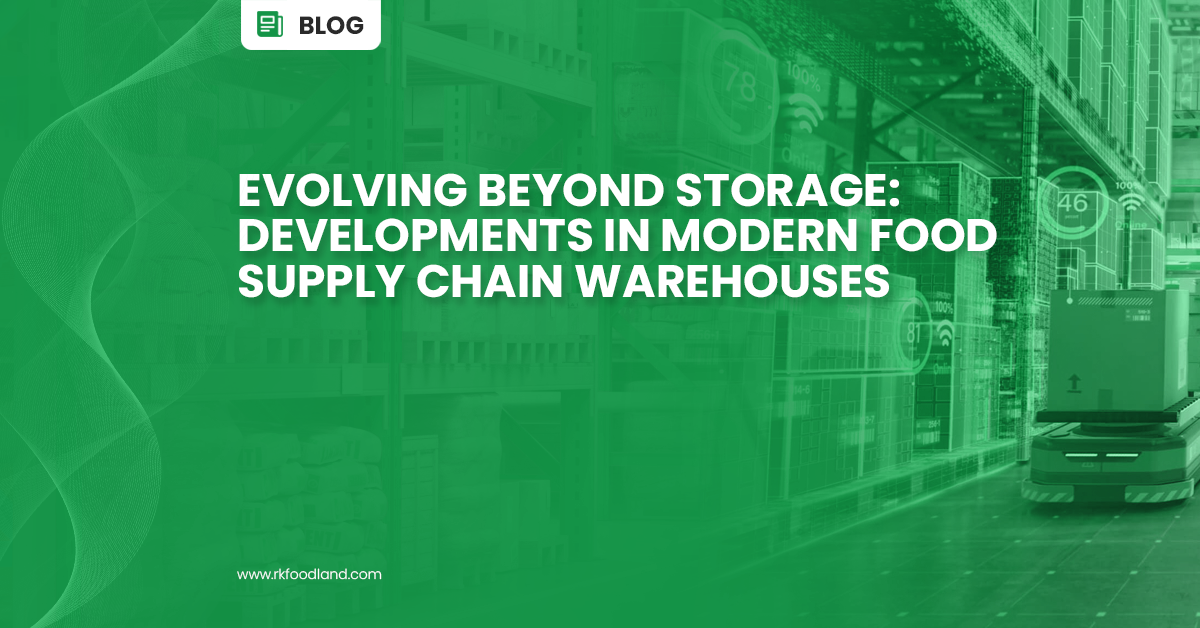
[Avg. Read Time < 5 mins]
Handling food warehousing can feel like a high-pressure race against time, primarily because of the perishable nature of many food items and the specific conditions they require for storage. Time plays a crucial role in ensuring food safety, maintaining quality, and facilitating efficient distribution. With growing consumer demands and the rising focus on food safety in our increasingly globalized world, the importance of warehouses is more significant than ever. These facilities have evolved from merely being storage units to becoming essential components of the supply chain, tasked with inventory control, order fulfilment, and quality assurance. This shift is evident as 77% of businesses now aspire to automate their operations using systems like WMS. The rapid expansion of new channels, driven by changing consumer behaviours and the penetration into new markets, has underscored the need for effective warehousing and reliable fulfilment partners. In this article, we will delve into the strategic advancements transforming food supply chain warehouses, underlining their evolution from mere storage spaces to critical component of the food supply chain.
Emerging Trends, Technologies, and Capabilities in Modern Warehousing
As we navigate the future of food supply chain management, we are witnessing a wave of transformative trends, technologies, and capabilities in modern warehousing. No longer limited to the conventional realms of storage and inventory management, today’s warehouses are increasingly adopting cutting-edge technologies, harnessing the power of digitization, automation, and advanced analytics. These emerging trends are redefining warehousing operations, optimizing efficiency, and carving a path to a resilient and agile supply chain landscape. Let’s delve into these revolutionary changes that are shaping the face of modern warehousing.
- Automated Guided Vehicles (AGVs) are being increasingly deployed for receiving and dispatching goods. These self-operating vehicles streamline the movement of goods, reducing the need for manual labor and minimizing errors. Complementing this is the use of Dock Scheduling Software, which optimizes the scheduling of inbound and outbound shipments, enhancing efficiency and throughput.
- Automated Storage and Retrieval Systems (ASRS) and Mobile Shelving Systems are not only maximizing space utilization beyond 85% but also speeding up the storage & retrieval, and increasing pick accuracy of items above 99%, thereby reducing the time food spends in the warehouse and ensuring its freshness.
- When it comes to packing and handling, Robotic Picking and Packaging systems are taking a centre stage. These systems, coupled with Smart Packaging technologies like RFID tags or QR codes, ensure accuracy in order fulfilment and real-time tracking of food items, a critical aspect in maintaining food safety.
- Inventory management, a key aspect of warehousing, is being transformed by Warehouse Management Systems (WMS), RFID technology, and sensors & monitors. These technologies have improved real-time inventory visibility from 2% to 20%, facilitating accurate tracking, and enabling efficient management of food items, thereby minimizing wastage and ensuring timely replenishment.
- Data management and exchange for quality and food safety are being bolstered by ERP Systems, cloud storage & sharing, and blockchain technology. These systems are ensuring secure, transparent, and efficient data management, which is crucial for maintaining food safety standards, regulatory compliance, and consumer trust.
- Recording and documentation processes are being streamlined with Central Command Systems and AI & Machine Learning-based Decision Support Systems. These technologies are enabling real-time monitoring, predictive analytics, and data-driven decision-making, thereby enhancing operational efficiency and strategic planning.
- Lastly, quality control, security, and compliance are being strengthened by Machine Learning algorithms and advanced security measures. These technologies are helping predict potential quality issues, ensuring adherence to food safety regulations, and safeguarding the warehouse from potential threats.
In essence, the modern warehouse is no longer just a storage facility. It’s a technologically advanced operation centre that leverages automation and data analytics to drive efficiency, accuracy, and growth. By embracing these emerging trends and technologies, food businesses can transform their supply chain operations and gain a competitive edge in the market.
Cost-Benefit Analysis of Modern Warehousing Technologies
Adoption of new technologies and innovations in warehousing can lead to benefits like increased efficiency, reduced errors, and enhanced traceability. However, to fully appreciate these benefits, it’s important to conduct a comprehensive cost-benefit analysis. When considering the cost of warehousing, it’s crucial to look beyond the initial investment in technology. The true cost should factor in efficiency gains, reduced wastage, and the potential for scalability.
- For instance, Automated Guided Vehicles and Automated Storage and Retrieval Systems may require a significant upfront investment, but they can dramatically increase operational efficiency and reduce labor costs in the long run.
- Similarly, technologies like Warehouse Management Systems (WMS) and Radio Frequency Identification (RFID) can enhance inventory management, reducing wastage due to spoilage or loss, and saving substantial costs over time.
- Moreover, the adoption of technologies like Robotic Picking and Packaging systems and Smart Packaging can improve order accuracy and enhance traceability, reducing costs associated with returns and recalls.
- Advanced data management systems like ERP and blockchain can ensure regulatory compliance, avoiding potential fines and protecting brand reputation.
However, for many businesses, the upfront cost of adopting these technologies can be a barrier. This is where partnering with a warehousing provider that leverages advanced technologies can be a game-changer. Such a partnership allows businesses to access the benefits of modern warehousing technologies without the need for a major upfront investment. It also provides the flexibility to scale operations up or down based on demand, further optimizing costs. Thus, it’s essential to view warehousing costs not just as an operational expense, but as a strategic investment.
How to Identify the Right Warehousing Partner?
Having established the strategic importance of modern warehousing and the cost-benefit analysis of adopting advanced technologies, the next crucial step is identifying the right warehousing partner. Identifying the right warehousing partner involves evaluating whether the potential partner aligns with your company’s business goals and operational strategies. Key factors to consider include their experience in the industry, the extent of their technology adoption, the strategic location of their facilities, their ability to scale operations in line with your business growth, and their customization capabilities to cater to your specific needs. Additionally, their financial stability and commitment to sustainability are also important considerations, as these factors can impact the long-term viability and reputation of your business. To assess the effectiveness of a potential warehousing partner, it’s beneficial to consider certain warehousing KPIs too. These may include the level of optimized inventories they can maintain and their order accuracy rate, the efficiency of their space utilization, and the streamlining of their processes. Evidence-driven KPIs, such as their track record in reduced stockouts and backorders, can provide tangible proof of their capabilities. In conclusion, choosing the right warehousing partner is a strategic decision that can significantly impact your business performance. By considering the right factors and KPIs, you can ensure that your warehousing partner is not just a service provider, but a strategic asset that drives your supply chain optimization and business growth.
So, are you ready to take your warehousing strategy to the next level? Interested in learning more about the latest technological developments in warehousing and how they can transform your food supply chain operations?
Our team of experts is here to help! At RK Foodland, we specialize in providing strategic warehousing solutions that are tailored to your unique business needs. Don’t miss out on the opportunity to optimize your supply chain, enhance efficiency, and drive business growth.
Connect with our experts today to explore how modern warehousing can become a strategic asset for your business.
Related Content | Foodland’s Resources
The top 5 smart warehouse technologies you should be using today
6 Ways How a Warehouse Management System Can Impact the Supply Chain?
Navigating dynamic labor: Building strong warehousing operations



